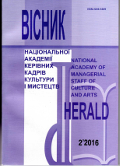THE COLOUR SYNERGETICS IN ADVERTISING COMMUNICATIONS OF THE POSTMODERN PERIOD
DOI:
https://doi.org/10.32461/2226-3209.2.2016.138514Keywords:
visual-verbal model of advertising, colour synergetics, stylistics of advertising graphics (Ad graphics), postmodernismAbstract
Purpose of the research. The purpose of the Study of Сolour in Advertising is to systematize the visual means of advertising communications and to define their functional and stylistic specificity within the Post-modernism. Methodology of the research is based on socio-cultural, axiological and comparative approaches to the analysis of visual Colour language on the example of Advertising graphics. Scientific originality. The author examines the Adver-tising industry not from the standpoint of economics, marketing or management, but in terms of its artistic level in the conditions of the global crisis of consumerism at the end of XX – beginning XXI century. Besides, the article defines the determination of stylistic trends and aesthetic problems of modern advertising in socio-cultural area. It pays special atten-tion to the significant deficiencies of advertising graphics in the context of popular culture: the advantage of stereotype, primitiveness, vulgarity and the actual lack of national imagery. Nowadays popart, kitsch and eclecticism dominate in advertising environment. The comparative analysis of forming factors in advertising has discovered that the visual range does not perform illustrative and decorative functions anymore, but becomes a cumulative visual-verbal model, the lan-guage of which relies on the methods and means of art in the postmodern period. The research examines the functions of colour in advertisements as phasing of perception (expressive, physiological, emotional, informative and positive-aesthetic). Conclusion. The synergetic possibilities of colour in advertisment design are revealed in the process of using creative technologies and finding original solutions to visualization of advertising ideas. Colour combinations in advertis-ing should be focused on the target audience and adjusted to the regional ethnic and cultural traditions. Advertising products for mass market should have the aesthetic level and perform cultural and educational functions.
Downloads
Published
Issue
Section
License
Authors who publish with this journal agree to the following terms:
1. Authors retain copyright and grant the journal right of first publication with the work simultaneously licensed under a Creative Commons Attribution License that allows others to share the work with an acknowledgement of the work's authorship and initial publication in this journal.
2. Authors are able to enter into separate, additional contractual arrangements for the non-exclusive distribution of the journal's published version of the work (e.g., post it to an institutional repository or publish it in a book), with an acknowledgement of its initial publication in this journal.
3. Authors are permitted and encouraged to post their work online (e.g., in institutional repositories or on their website) prior to and during the submission process, as it can lead to productive exchanges, as well as earlier and greater citation of published work (See The Effect of Open Access).


